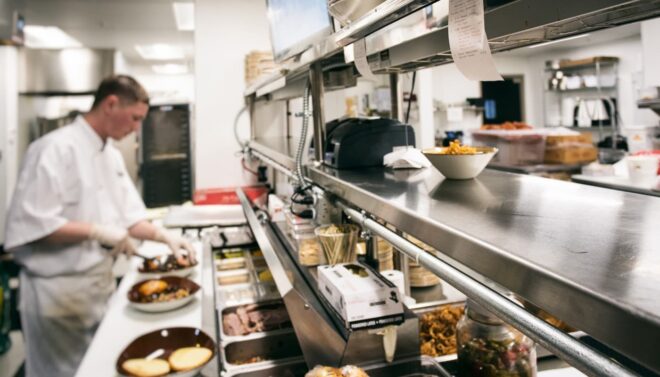How much do restaurant employees make?
Editorial Team
7 min read
In the bustling restaurant industry, understanding how much employees make is crucial for both owners and workers alike. Whether you’re running a small café or a large fine-dining establishment, knowing the pay rates for different positions can help to ensure fair compensation, foster a more positive work environment, and aid in retaining talented staff.
Join us as we dive into the average wages for common restaurant positions, some of the factors that can influence pay, and how tools like Clover’s restaurant POS system can simplify employee payments, including managing tips.
Common restaurant employee roles and average wages
When it comes to restaurant staffing, there’s a wide range of positions, each with its own unique set of responsibilities and compensation levels. Let’s break down the most common of these roles and their average wages for front of house, back of house, and restaurant management.
Front of house (FOH) staff
- Servers: Servers are the heart of the dining experience, interacting with customers, managing orders, and ensuring guests are taken care of. A server’s hourly wage typically ranges from $2.13 to $16, depending on state laws regarding tipped workers. Though the majority of their income often comes from tips, which can put their mean for total hourly earnings at $17.56.
- Hosts: Hosts manage the flow of guests, take reservations, and set the tone for the overall dining experience. A restaurant host’s hourly wage normally ranges between $10 to $24 per hour on average, with potential for tips in some establishments.
- Bartenders: Bartenders prepare drinks, manage the bar area, and often engage with customers directly. The mean bartender hourly wage nears $17.83 per hour, but like servers, they heavily rely on tips. On a busy night, a bartender can potentially earn an additional $50 to $200+ in tips in total.
- Barbacks and bussers: Barbacks assist bartenders with stocking and cleaning, while bussers help clear tables and maintain overall restaurant cleanliness. Both positions typically earn between $6 to $19 per hour on average, often with a share of the tips from the bartender or server if tips are pooled.
Back of house (BOH) staff
- Line cooks and prep cooks: These employees handle the preparation and cooking of food in a restaurant kitchen. Line cooks typically earn between $10 to $22 per hour, while a prep cook hourly wage ranges from $10 to $20 on average. Like with any professional role – experience, restaurant type, and location can all influence these hourly rates.
- Chefs and sous chefs: Chefs, including sous chefs, manage the kitchen, plan menus, and supervise staff. Depending on the size and type of the restaurant, chef wages per hour range anywhere from $10 to $34 or more.
- Dishwashers: Dishwashers, arguably the most important role in a restaurant, are responsible for the cleaning and sanitization of dishes and kitchen equipment. A dishwasher’s wage per hour usually ranges from $12 to $20, depending on the location, size, and type of restaurant establishment.
Management and specialized soles
- General managers: General managers oversee all restaurant operations, including staffing, budgeting, and customer service. General manager salaries range from $43,000 to $79,000 per year, depending on the restaurant’s size and location.
- Executive chefs: Executive chefs are responsible for overall kitchen management, including menu creation and food quality. An executive chef salary ranges between $56,000 to $112,000 per year on average or more, especially in fine dining settings.
- Assistant managers and other specialized roles: Assistant managers and those with specialized roles, such as a pastry cook, often earn between $26,000 to $59,000+ annually.
Factors that can affect restaurant employee pay
Restaurant wages are influenced by several key factors, ranging from the restaurant’s location to the employee’s experience. Here are some to consider when determining payment for your restaurant employees.
Geographic location
Wages can vary significantly depending on where the restaurant is located. In cities with a high cost of living like New York or San Francisco, restaurant employees often earn more to offset living expenses. Conversely, wages might be lower in rural areas or smaller towns. This can be important to consider when determining employee wages to ensure that they can afford to live where they work.
Type of restaurant
The type of establishment also plays a significant role in determining pay. Fine dining restaurants usually offer higher wages and tips compared to fast-casual or quick-service restaurants. This is because the check size, and consequently the tip amount, is often higher in upscale dining settings as well as their standards for service.
Experience and skill level
Experience and skill level are major factors in determining restaurant wages. For example, a seasoned chef with a strong portfolio can command a significantly higher salary than someone just starting out in their career. Similarly, servers with extensive experience in high-end restaurants might earn more than those new to the industry.
Tip culture and tip pooling
In many restaurants, tips are a substantial part of employees’ income. Tip pooling, where all tips are collected and redistributed among staff, can provide a fairer distribution of gratuities, ensuring that everyone from servers to dishwashers benefits. This approach can reduce income disparity among staff members and foster a sense of teamwork.
Restaurant legal requirements and minimum wage standards
Determining the hourly rate of your employees may seem simple, but restaurant owners must also navigate a complex landscape of wage laws to ensure compliance as well as fair compensation to legally operate.
Federal and state minimum wage laws
The federal minimum wage for tipped workers is $2.13 per hour, while for non-tipped workers, it’s $7.25 per hour. However, many states have their own minimum wage laws, which can significantly exceed the federal standard. For example, California requires employers to pay a minimum wage of $16 per hour regardless of tips.
Overtime pay regulations
Federal law mandates that non-exempt employees working more than 40 hours per week must receive overtime payment at 1.5 times their regular hourly rate. This makes it critically important for restaurant owners to track hours accurately and ensure they comply with both state and federal regulations regarding overtime.
Additional compensation considerations
Aside from competitive wages, many savvy restaurants offer benefits including health insurance, paid time off, and retirement plans. These benefits can be crucial in attracting and retaining talented staff, particularly in a competitive job market. It can also be helpful to consider other fringe benefits such as discounts, free shift meals, and team building experiences that can make for a more appealing payment package in tandem with these other compensation considerations.
How Clover POS systems streamline paying employees
Managing employee payments in a restaurant can be complex, with varying wages, tips, and overtime to consider. This is where Clover POS systems come in to simplify the process and ensure employees are paid what they are owed on time.
Simplified payroll management
ADP Workforce Management is a comprehensive solution for scheduling, payroll, and team management. It enables seamless communication with your team, while employees can independently swap shifts and access updated schedules with reminders. Plus, you can effortlessly convert timesheets into wages and manage payroll taxes automatically. Whether managing technicians, contractors, or employees, ADP simplifies team management with minimal effort. This helps to ensure that employees are paid accurately and on time, which can help reduce administrative burdens on restaurant owners or managers as well as support in keeping employees happy and healthy.
Tip management
Managing tips is simple and straightforward with Clover. With built-in features for tracking and pooling tips, restaurant owners can easily ensure fair distribution among staff while staying compliant with legal requirements. This transparency can also help with fostering trust among employees and reduces the potential for disputes.
Data and insights
Clover POS software can help provide valuable insights into labor costs and employee performance. Restaurant owners can use this data to make informed decisions about scheduling, hiring, and wage adjustments. For example, understanding peak hours and employee productivity can help optimize staffing, ultimately leading to better service and increased profitability for your restaurant.
Paying your restaurant employees is easy with Clover
Understanding how much restaurant employees make is essential for maintaining fair compensation, reducing turnover, and fostering a positive work environment. From front of house servers to back of house chefs, wages vary widely depending on role, location, and experience. By using tools like Clover POS systems, restaurant owners can simplify employee payments, manage tips effectively, and ensure compliance with wage laws, all while maintaining a more satisfied and motivated team.
If you’re looking to streamline your payroll process and make managing tips easier, consider integrating Clover POS systems into your restaurant’s operations today.
This information is provided for informational purposes only and should not be construed as legal, financial, or tax advice. Readers should contact their attorneys, financial advisors, or tax professionals to obtain advice with respect to any particular matter.
Related Posts
Health code violations: What they are & how to prepare for an inspection
What small businesses should look for in a POS system
Popular Topics
Stay in touch
Sign up and learn more about Clover.
Thank you for your subscription!
More posts about starting a small business
eBook





